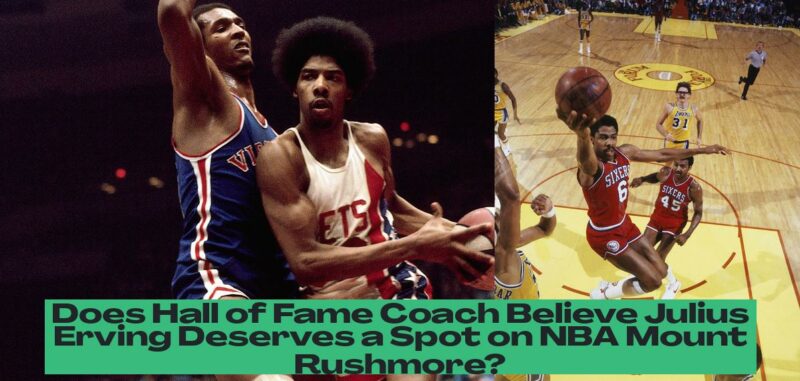Hall of Fame Coach Thinks Julius Erving Belongs On NBA Mount Rushmore
The debate about the NBA’s Mount Rushmore is a perennial one, with fans and experts alike arguing over who deserves a spot among the league’s greatest. While names like Michael Jordan, LeBron James, and Kareem Abdul-Jabbar are consistently mentioned, former NBA coach and Hall of Famer George Karl has sparked controversy by advocating for Julius “Dr. J” Erving to be included in this elite group.
Karl’s stance stems from a social media post on X (formerly Twitter) that featured Michael Jordan, Steph Curry, LeBron James, and Kobe Bryant as the league’s Mount Rushmore. Karl took exception to this list, arguing that “Anyone who doesn’t put Julius on their Rushmore of pro hoops greats doesn’t know the history of the sport.”
This statement ignited a firestorm of debate, with many fans and analysts questioning whether Erving truly deserves a place among the NBA’s all-time greats. While Erving is undoubtedly one of the most iconic and influential players in basketball history, his accomplishments are often overshadowed by the achievements of later stars.
Erving’s legacy is intertwined with the American Basketball Association (ABA), where he won two championships with the Virginia Squires and New York Nets. However, the ABA was absorbed into the NBA in 1976, and many argue that Erving’s achievements in the ABA should not be considered when evaluating his overall impact on the NBA.
Despite this, Erving’s impact on the NBA is undeniable. He brought a unique blend of athleticism, style, and flair to the game, revolutionizing the way small forwards were viewed. His iconic dunks, including the “Dr. J” reverse slam, captivated audiences and elevated the popularity of the NBA.
- Hall of Fame coach George Karl believes Julius Erving belongs on the NBA Mount Rushmore.
- Erving’s impact on the NBA is undeniable, revolutionizing the game with his athleticism and style.
- Erving won three championships, four MVP awards, and three scoring titles during his career.
- Debate surrounds Erving’s legacy due to his success in the ABA, which merged with the NBA in 1976.
- Supporters argue that Erving’s cultural impact and influence on the game should secure his spot among the all-time greats.
The Case for Julius Erving
Proponents of Erving’s inclusion on the Mount Rushmore point to his dominance during his prime. He won three championships (two ABA and one NBA), four Most Valuable Player Awards (three ABA and one NBA), and three scoring titles. His impact extended beyond the court, as he became a cultural phenomenon, inspiring a generation of players and fans with his electrifying style.
Erving’s supporters argue that his contributions to the game should not be overlooked simply because he played in a different era. They highlight his ability to dominate opponents despite facing less competition than players in today’s NBA. They also argue that his impact on the game’s evolution, particularly the development of the small forward position, is immeasurable.
While Erving’s achievements are undeniable, the question remains whether he is among the top four players of all time. The debate is complicated by the fact that the NBA has evolved significantly since Erving’s era, making direct comparisons difficult.
The Counterarguments
Critics of Erving’s Mount Rushmore inclusion point to the fact that he only won one NBA championship, compared to the multiple championships won by Michael Jordan, LeBron James, and Kobe Bryant. They argue that while Erving was a dominant player, his overall impact on the game is less significant than these players.
Some also argue that Erving’s tenure in the ABA, while impressive, does not hold the same weight as a career spent entirely in the NBA. They point out that the ABA was a lower level of competition, and that Erving’s success in that league does not necessarily translate to the same level of dominance in the NBA.
Finally, many argue that other players, such as Tim Duncan, Larry Bird, Magic Johnson, or Kareem Abdul-Jabbar, have a stronger case for inclusion on the Mount Rushmore. These players have achieved more championship success, have had a greater impact on team dynamics, and have been consistently considered among the best players of all time.
Where Does Julius Erving Rank?
While the debate over Erving’s inclusion on the NBA’s Mount Rushmore is likely to continue, there is no denying his place among the all-time greats. He revolutionized the small forward position, introduced a new level of athleticism to the game, and inspired countless players and fans.
Whether he deserves a place on the Mount Rushmore is a matter of opinion, but his impact on the game is undeniable. He is a legend whose contributions to basketball history will continue to be celebrated for generations to come.
In conclusion, the debate surrounding Julius Erving’s place on the NBA’s Mount Rushmore highlights the subjective nature of ranking players across different eras. While Erving’s achievements are undeniable, his inclusion among the top four players of all time is a matter of opinion. However, his legacy as one of the most iconic and influential players in basketball history is secure.









